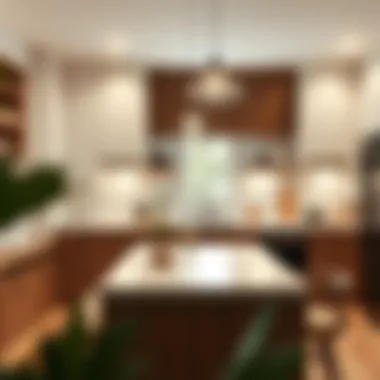Effective Room Layout Templates for Space Efficiency


Intro
In the realm of interior design, the layout of a room can either make or break the space's functionality and aesthetic appeal. A well-thought-out room arrangement not only enhances the comfort of a living environment, but it also reflects the personality and style of the homeowner. In embarking on the journey of room layout planning, it’s essential to strike a harmonious balance between practical utility and visual elegance.
When creating a layout, numerous factors come into play — from the dimensions of the space to the intended function of each area. Homeowners, designers, and enthusiasts alike can benefit greatly from established templates that simplify the decision-making process. With a keen understanding of furniture styles and placement strategies, one can transform even the most challenging spaces into inviting havens.
This guide will delve into crucial themes, shedding light on furniture styles and trends, effective arrangement techniques, and the importance of maintenance. Each section will provide insights that cater not just to the design novice but also to those seasoned in the art of home decor. Armed with these principles, anyone can embark on an adventure into the heart of their home, discovering new ways to optimize their space.
Let’s begin with an exploration of the varying furniture styles that set the stage for effective room layout templates.
Understanding Room Layouts
Grasping the concept of room layouts is pivotal for anyone stepping into the realm of interior design or simply looking to optimize their living spaces. A well-thought-out room layout doesn't just cultivate aesthetic appeal; it significantly enhances the functionality of the space, creating a harmonious balance that ultimately enriches our everyday experiences. When it comes to designing interiors, understanding how to align practical needs with the preferred aesthetics sets the groundwork for effective room utilization.
Principles of Spatial Arrangement
The principles of spatial arrangement act like the guiding star in any design endeavor. One key principle is the notion of zoning, where different areas are assigned specific functions. For instance, in an open-concept living room, one corner might serve as a cozy reading nook, while another is dedicated to social gatherings. This clear demarcation allows for a smoother flow and makes navigating the space feel more intuitive.
Another significant aspect is proportion and scale. Selecting furniture that aligns with the room's dimensions is crucial. Oversized furniture in a compact area feels clunky, while too-small pieces can make it feel barren.
Moreover, visual lines also contribute profoundly to how spacious a room appears. Using long lines, such as a continuous sofa or a long dining table, can create the illusion of more space, directing the gaze deeper into the room. These elements intertwine seamlessly to create a spatial narrative that not only delights the eyes but also meets the functional needs of the homeowners.
The Role of Functionality in Design
Functionality is often the backbone of a good room layout. When sitting down to design, it’s essential to prioritize how a space will be used on a daily basis. Let's not kid ourselves; if a layout looks good but falls short in practicality, it’s not worth its weight in gold.
User requirements must shape every design decision made. A family with young children may prioritize open spaces that allow for play, while someone working from home may require a dedicated office corner. By placing functionality at the forefront, designers can ensure that spaces are tailored to the lives of those living in them.
Another critical aspect is the arrangement of furniture around daily routines. Think about how one might arrange seating in a dining room. If the chairs are too far from the table, it makes dining awkward and uncomfortable. Instead, ensuring easy access to seating enhances both daily use and aesthetic flow.
Aesthetic Considerations in Layouts
Aesthetics in room layout cannot be overlooked; they play a fundamental role in the design. The visual appeal of a space can dramatically affect the mood and perceived comfort of inhabitants. For example, color schemes used in a room can create feelings of warmth or coolness. Using neutral tones with pops of color can invoke a lively buzz, while muted colors may bring about serenity.
Additionally, furniture selection goes hand in hand with aesthetics. The style, material, and colors must resonate with the intended theme of the space. A room decorated with sleek, modern furniture would clash with heavy antique pieces. This mismatch can tug at a viewer's senses, undermining the cohesive flow of the room.
When it comes down to it, displays and decor are like the icing on the cake. Carefully selected artwork, plants, and accessories can underscore the intended mood, making the space feel more personalized.
Ultimately, understanding room layouts is not just about arranging furniture or selecting colors. It’s about creating a functional, beautiful space that enriches the quality of life for its inhabitants.
Types of Room Layouts
Understanding types of room layouts is essential for maximizing space utilization in any home or office. Room layouts function as a blueprint that dictates the flow, function, and overall feel of a space. By selecting the right layout, homeowners and designers can greatly enhance both the practicality and aesthetic appeal of interiors. This section dives into three distinct styles: Open Concept Spaces, Traditional Room Configurations, and Multi-Functional Areas.
Open Concept Spaces
Open concept spaces are all the rage in modern design, offering the charm of fluid layouts that create a seamless transition between various areas, such as the kitchen, dining, and living spaces. One significant advantage is that these environments tend to feel more spacious, allowing natural light to flow freely throughout the area.
- Benefits of Open Concept:
- Enhanced Interaction: In an open space, family members can engage with one another while cooking, working, or lounging, promoting a sense of togetherness.
- Versatile Use of Area: These layouts can adapt to various needs by rearranging furniture, which makes them ideal for hosting gatherings, family meals, or casual activities.
However, some considerations arise. Noise can be a significant issue, as sounds from one space easily carry into another. Moreover, ensuring enough privacy can be tricky; thoughtful placement of furniture can help, but it's not a full solution. Homeowners often weigh these pros and cons when deciding on such layouts.
Traditional Room Configurations
Coming back to the basics, traditional room configurations typically feature clearly defined areas for specific functions—think of a separate living room, dining room, and bedroom. This layout provides a sense of orderliness and privacy, making it especially appealing for families or those who value compartmentalization.
- Key Features of Traditional Layouts:
- Defined Spaces: Each room has a specific purpose, reducing chaos and distraction.
- Distinct Decor: An opportunity for unique styles and themes in each room can flourish, allowing homeowners to express individuality through decor.
Nevertheless, this method can feel constraining and may limit the interaction among family members. Additionally, optimizing smaller spaces might be a challenge, leaving areas feeling cramped.


Multi-Functional Areas
Multi-functional areas bring a fresh twist to conventional layouts. By cleverly merging different uses into one space, these designs cater to a variety of activities. For instance, a living room could host both a workspace and a relaxation area through designated zones.
- Advantages of Multi-Functional Spaces:
- Efficiency: Using each square foot wisely, especially in smaller homes, allows for more freedom and flexibility.
- Customization: The adaptability of multi-functional layouts makes it easy for residents to change the space as their needs evolve.
However, there are pitfalls to navigate when dealing with multi-functional spaces. If not planned carefully, these areas can lead to a lack of clarity in function. Homeowners may find it challenging to balance aesthetic cohesiveness with practical demands, requiring thoughtful planning and creative solutions.
A well-thought-out room layout not only enhances functionality but also adds emotional value to space.
In summary, exploring different types of room layouts can provide significant benefits for homeowners and designers. The goal is to find a balance between functionality, aesthetics, and personal preference. Understanding the unique advantages and challenges of each layout type equips individuals to create a space that is not just livable but also resonates with their lifestyle and design sensibilities.
Creating a Room Layout Template
When it comes to designing a space, creating a room layout template is both a science and an art. This process not only necessitates practical considerations but also invites creativity to flourish. Understanding how to craft a thoughtful and functional room layout can empower homeowners and designers to actually make the most of their available space while addressing individual needs and preferences. The benefits of meticulously creating a room layout template extend far beyond aesthetics; they foster an environment that promotes comfort, functionality, and efficiency.
Identifying User Needs and Preferences
At the core of any successful room layout lies a deep understanding of the users inhabiting that space. Before sketching any designs, it's crucial to engage in conversations about what individuals actually want and need from their environment. This discussion should delve into specific aspects such as:
- Lifestyle needs: Consider how the inhabitants will use the space. For example, a family with children may prioritize play areas, while a single professional might desire a home office.
- Ambience and mood: Each person will have different preferences for visual and emotional aspects. Ask them to envision their ideal space—cozy, vibrant, or perhaps minimalistic.
- Accessibility: Identify if there are any special requirements based on mobility or other health considerations. This aspect can greatly influence how the layout shapes up.
By gathering this information, you can create a profile that captures the essence of user needs. Tailoring the space according to identified preferences not only enhances the satisfaction of the users but also fosters a sense of belonging within the environment.
Measuring Available Space
Once you have a handle on user needs and preferences, the next logical step is to take accurate measurements of the available space. This process involves more than just flicking on a tape measure; it's about quantifying the soul of the room. Consider the following points:
- Wall measurements: Don’t forget to include doors and windows in your calculations. Natural light is a vital element that can dramatically alter how a room feels.
- Obstructions: Identify any permanent structures, such as radiators or built-in furniture, that may affect the layout. Knowing where these fixtures sit can guide more effective designs.
- Vertical space: Room height is just as important as floor space. Think about incorporating shelving or vertical storage solutions that can make the most out of that air above.
Taking an honest look at what you’re working with empowers you to create a layout that flows well. Accurate measurements can save time and resources down the road, preventing the unfortunate situation of purchasing furniture that simply won't fit.
Sketching Initial Layouts
With user preferences and measurements in hand, the exciting part begins—sketching initial layouts. This is your chance to let creativity run wild while still adhering to practical constraints. Here are some tips to consider during this phase:
- Room zones: Start by identifying areas for distinct activities, for instance, a reading nook, workspace, and lounging area. Assigning these zones will help you visualize spatial arrangement.
- Scale and proportion: Keep the dimensions of the furniture in mind as you sketch. What might look good in a drawing can quickly result in a cramped scenario when placed in real life.
- Variations: Don’t settle on just one layout. Create several variations to evaluate different configurations. Sometimes the unexpected can yield the most rewarding results.
As you finalize these sketches, ensure they reflect the user needs established earlier. The layout should resonate with them, appearing both functional and inviting.
"Good design is about making spaces that work for the people who live in them."
Creating a room layout template is about so much more than just arranging furniture. It’s an invitation to fuse the user’s needs with an imaginative approach to space. When you start with an understanding of who will use the space and the measurements that inform your decisions, you're well on your way to striking a balance between form and function.
Furniture Arrangement Techniques
When it comes to room layout, the arrangement of furniture takes center stage. It's not just about plopping down chairs and a sofa; it’s about crafting an environment that resonates with functionality while maintaining aesthetics. Effective furniture arrangement can significantly enhance the livability of a space, making it feel open, welcoming, and suitably tailored to its uses.
Focal Points and Their Importance
Creating a focal point is like setting the stage for the rest of your design choices. Every room should have one, whether it’s a striking piece of art, a fireplace, or a beautiful view through the window. This draws the eye and can dictate the placement of other furniture pieces.
Consider this: if you've got a magnificent bay window, why not situate your couch to face it? In doing so, you're not only optimizing the use of natural light, but also enabling conversations to flow around this central feature. Focal points can also serve as conversation starters or simply add a sense of tranquility to the room.
"A room without a focal point is like a book without a plot. It lacks direction."
By thoughtfully arranging furniture around this centerpiece, you ensure that the layout feels coherent, as each piece contributes to the overall flow and function of the space.
Traffic Flow Considerations
A well-executed room layout respects traffic flow, allowing movement through the space without obstacles. Think about the natural paths people take as they move through a room. You wouldn't want to place a coffee table smack-dab in the middle of the walkway.
To achieve smooth traffic flow:


- Define pathways: About 24 to 30 inches of clearance is ideal for walkways.
- Group furniture: Create clusters of seating or activity areas that don’t interfere with movement.
- Visual cues: Use rugs or furniture arrangements to signal the boundaries of different areas.
Ensuring that movement is unencumbered not only makes the space more practical but also adds to the overall comfort of the environment.
Balancing Visual Weight
Every room possesses a visual weight; this relates to how heavy or light different elements feel within a space. Balancing visual weight can create harmony, preventing any one area from feeling too crowded or sparse. For instance, if you have a large sectional sofa on one side of the room, balance it out with a few lighter pieces opposite, like slim chairs or low-profile storage units.
- Contrast textures: Pair heavy fabrics with lighter ones to create interest and movement.
- Use colors wisely: Dark colors may seem heavier than lighter shades, so distribute them evenly across the space to prevent lopsidedness.
- Consider scale: Place larger pieces, like bookshelves or bulky chairs, in conjunction with smaller accents to ensure balance without overwhelming the room.
Finding this equilibrium draws on both personal taste and the physical characteristics of the items you choose, leading to a room that feels both inviting and thoughtfully arranged.
Utilizing Technology in Room Design
Embracing technology in room design has become not just a trend but a necessity for today’s designers and homeowners alike. As we navigate an increasingly interconnected world, the quest for creating practical yet aesthetically pleasing spaces intensifies. Technology serves as an essential ally in achieving this balance. It streamlines design processes, enhances visualization, and allows for greater flexibility in layout decisions. This section will explore the pivotal tools and technologies that can enhance your approach to room layout planning.
Room Design Software Options
In today's design landscape, a myriad of software options are available, each with its own unique advantages and features. These tools enable users to create intricate room layouts accurately and efficiently, often with just a few clicks. Some notable options include:
- SketchUp: This software allows for 3D modeling, making it easier to visualize space and furniture without having to physically rearrange anything. Users can easily modify designs and explore various layouts.
- AutoCAD: A favorite among professionals, AutoCAD offers precision in drafting and is ideal for those looking to delve deep into technical aspects of room design.
- RoomSketcher: User-friendly and accessible, this option is great for DIY enthusiasts. It offers drag-and-drop functionality to create layouts quickly and enables 3D visualization of designs.
- Homestyler: Perfect for those newer to design, it provides templates and a simple interface that allows users to experiment without overwhelming complexity.
When selecting software, consider your specific needs. Whether you are a homeowner aiming to rearrange your living room or a professional designer seeking advanced modeling features, there’s a tool tailored for you.
Virtual Reality Tools for Layout Planning
The introduction of virtual reality (VR) technology into room design planning is a game changer. With VR, users can immerse themselves in a virtual space prior to committing to any layout decisions. This capability profoundly enhances the design experience by providing several advantages:
- Realistic Visualization: Instead of relying on 2D sketches or static images, VR allows users to step into their designs. They can move around the space, assess proportions, and feel the flow in ways that flat images simply cannot replicate.
- Interactive Testing: Users can play around with different furniture arrangements and color schemes in real-time, receiving immediate feedback on their choices. This flexibility fosters creativity and can lead to more satisfying design outcomes.
- Space Optimization: VR tools even allow users to simulate traffic flow and space usage, ensuring that engagement with the space is optimal before the final layout is decided.
As you consider incorporating VR into your design process, remember to ensure that you have the necessary hardware and software to support it. Investing in VR can yield dividends by saving time and resources in the long term, providing a clearer picture of your envisioned space.
"Technology is best when it brings people together." - Matt Mullenweg
In summary, utilizing technology in room design not only enhances efficiency but also enriches the overall experience. By leveraging software options and virtual reality tools, homeowners and designers can collaborate more effectively and create layouts that truly reflect their individual needs and aesthetics. Looking ahead, as technology continues to evolve, its integration into room design will undoubtedly open new avenues for innovation and creativity.
Common Mistakes in Room Layout Planning
Creating a room layout is no small task. It encompasses the careful consideration of space, functionality, and aesthetics. However, many people tend to overlook fundamental aspects, leading to unpleasant surprises down the road. Being aware of common mistakes can save homeowners, designers, and DIY enthusiasts a world of trouble. Understanding these pitfalls helps in crafting a space that not only looks good but also works well in daily life.
Overcrowding the Space
One of the most prevalent errors in room layout planning is overcrowding the space, which often stems from a deep desire to fill a room with an assortment of furniture and decorations. In many cases, homeowners might think that more stuff equates to a more inviting or stylish environment. Yet, the opposite is often true.
When a space is stuffed to the brim, it can feel chaotic and constrictive. This lack of whitespace can lead to discomfort, affecting how one navigates or uses the area. For instance, cramming a large sectional sofa, a coffee table, and various side tables into a small living room can create a bottleneck effect. People may find themselves tripping over furniture just to get from one side of the room to the other. Consequently, it’s crucial to prioritize open areas.
To avoid overcrowding, consider the following:
- Be selective: Choose only essential items and a few focal pieces that resonate with your style.
- Leave room for movement: There should be enough space for people to walk around seamlessly.
- Utilize vertical space: Instead of adding more furniture, think of hanging shelves or wall-mounted decor which keeps floors clear while showcasing personal taste.
Ignoring Scale and Proportion
Ignoring scale and proportion is another trap that many fall into while planning room layouts. It’s tempting to select the trendiest pieces without considering if they actually fit well in the designated space. An oversized sofa in a cozy apartment, for instance, can dwarf the room, making it feel smaller and more crammed.
It’s essential to consider not just the size of individual pieces but how they relate to one another. For example, a tall bookcase next to a compact desk can create an unbalanced visual experience, leading to discomfort for the eye.
When assessing scale and proportion, these strategies can be beneficial:
- Measure beforehand: Always take accurate measurements of your space. Bring a tape measure when shopping to visualize how pieces will fit.
- Create a mock-up: Use painter’s tape to outline where furniture will go, helping you visualize space before making purchases.
- Consider the ceiling height: Taller furniture can enhance verticality in rooms with high ceilings, while shorter pieces are optimal for snug areas.
Neglecting Functionality
Lastly, neglecting functionality can turn a thoughtfully designed room into a frustrating space. It’s easy to focus on aesthetics alone, envisioning the color schemes and furniture layouts that look appealing. However, if these items don’t serve practical purposes, the room will eventually become a source of headaches.


For instance, a beautiful dining table that doesn’t provide enough seating or a home office setup lacking adequate lighting can hinder daily activities.
To ensure that layouts are functional:
- Identify specific needs: Before planning a layout, address what activities will predominantly take place in the space. Do you host diners often? Is it crucial for the home office to be quiet?
- Incorporate flexibility: Establish areas that can adapt to various functions. An expandable dining table or movable furniture can significantly enhance functionality.
- Consider future needs: Think ahead—will your family's needs change? Maybe a corner of the room that serves as a homework nook now could be a play area later.
Remember, it's not just about how a room looks on the surface; it’s about how it feels and functions daily.
By avoiding these common pitfalls, anyone can maximize room potential. Balancing aesthetics with practicality while being mindful of space can lead to a layout that genuinely enhances the living environment.
Case Studies of Successful Room Layouts
Analyzing real-life examples of room layouts offers invaluable insights into effective space utilization. These case studies not only showcase the application of design principles but also highlight the diverse needs that different living situations can present. By examining successful implementations, homeowners and designers can glean practical strategies and innovative solutions that resonate with their unique contexts.
Case studies provide a tangible reference that helps us to visualize concepts in action. They illustrate how thoughtful planning can transform a space into one that is not only functional but also aesthetically pleasing. Here are three relevant examples focusing on small apartment solutions, family-friendly designs, and working-from-home arrangements.
Small Apartment Solutions
In bustling urban environments where square footage comes at a premium, small apartments often present layout challenges. One noteworthy case study involves a compact studio apartment in New York City. The owner opted for a multi-purpose furniture strategy, employing a Murphy bed that folds down from the wall, optimizing floor space.
- Zoning Techniques: The layout incorporated zoning ideas by using area rugs to define different sections, creating a living area, and a workspace.
- Vertical Space Usage: Wall-mounted shelves showcased decorative items while serving practical needs, and a collapsible dining table allowed for additional surface area when needed.
- Natural Light: Wide windows were kept unblocked, promoting light flow, which made the space feel larger.
Such innovative solutions demonstrate how small areas can be transformed with creativity and the right furnishings.
"A small space doesn't mean you have to compromise on style or comfort. It's all about strategic planning and smart usage of every inch."
Family-Friendly Designs
Family living often demands layouts that accommodate various activities and age groups. A recent project in a suburban home illustrates how a family effectively adapted their living space.
- Open Plan Layout: The heart of the home was an open-concept kitchen, living, and dining area. This layout not only encourages family interaction but provides flexibility for multiple activities to occur simultaneously.
- Defined Play Areas: A section was dedicated as a play area for children, utilizing durable materials resistant to spills and damages while keeping safety in mind.
- Flexible Furniture: The use of modular furniture such as ottomans that can be easily moved however needed facilitates quick changes to the layout when entertaining or during playtime.
These adjustments resulted in a family-friendly atmosphere that catered to everyone's needs without feeling cluttered.
Working from Home Arrangements
With the rise of remote work, a thoughtful approach towards home office integration becomes increasingly relevant. A case study of a modern home illustrates significant considerations for creating a conducive work environment within a residential setting:
- Dedicated Office Nook: The design included a small, dedicated nook separate from the main living areas to help create boundaries between work and personal life. This was achieved without detracting from the overall aesthetics of the home.
- Ergonomic Furniture: Ergonomics took center stage with a proper desk and an adjustable chair to enable comfort during long hours of work.
- Acoustic Solutions: Acoustic panels were added to manage sound, creating a quiet space away from distractions.
These adjustments catered to the modern work-from-home lifestyle, merging productivity with home comfort.
Through the examination of these case studies, it’s evident how design can play a critical role in shaping life experiences. Whether optimizing a small apartment or accommodating family needs, these real-world solutions offer a wealth of knowledge for informed decisions in any layout project.
Future Trends in Room Layout Design
In the ever-evolving realm of interior design, understanding future trends can truly shape how spaces are utilized. As we step into a world where technology meets sustainability, the landscape of room layouts is changing. Homeowners, designers, and enthusiasts alike should remain attuned to these shifts. Recognizing these trends not only enhances functional aspects of living spaces but also caters to modern aesthetic preferences. From eco-conscious materials to the seamless integration of smart technologies, these elements not only make spaces more livable but also future-proof them against evolving needs.
Sustainable Materials and Practices
As sustainability becomes a crucial focus across various industries, the interior design realm is no exception. Using sustainable materials not only minimizes environmental impact but also elevates the overall appeal of a space.
Key considerations include:
- Reclaimed Wood: Utilizing reclaimed timber adds warmth and character while reducing waste.
- Bamboo: Known for its rapid growth, bamboo serves as a sustainable alternative to conventional hardwoods.
- Recycled Materials: Incorporating recycled metals, plastics, or textiles can add a unique touch to room layouts.
Incorporating these materials is just the start. Sustainable practices like energy-efficient lighting, efficient HVAC systems, and enhancing natural ventilation can drastically improve a room's energy profile. Homes that embrace these elements not only stand out but also create healthier environments for occupants.
"Sustainability isn’t just a trend; it's the groundwork for the homes of tomorrow."
Integration of Smart Home Technology
Smart home technology is carving its niche within interior design, blurring the lines between functionality and convenience. Implementing tech-savvy solutions can revolutionize how spaces are navigated and enjoyed.
Some notable benefits include:
- Automation: Automated systems allow homeowners to control lighting, temperature, and security with just a few taps on their smartphones.
- Space Optimization: Smart furniture that adjusts to user needs can convert spaces for various activities, making them versatile and functional.
- Energy Efficiency: Technologies promoting energy savings contribute to long-term sustainability goals.
Moreover, the future of room layouts might involve building designs that automatically adapt to changing weather conditions, creating an indoor climate that is always comfortable. This integration serves to enhance not just convenience, but also livability, making homes more welcoming.
In summary, keeping a pulse on these trends—sustainability and smart technology—ensures that designs remain relevant and efficient. In this fast-paced world, where change is the only constant, adapting room layouts to future needs is not just advisable, it's essential.















